Specialities
Mini-Kiwi | Rhubarb | Fig | Haskap | Serviceberry | Chokeberry |
Gojiberry |Crimson Star| Elderberry | Sea Buckthorn| Powpow | Grapevine
Mini-Kiwi / Kiwiberry (Actinidia arguta)
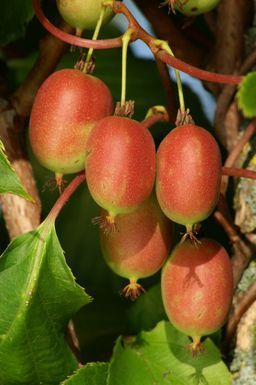
The sharp-toothed ray-pod, more commonly known as the "mini kiwi" is originally from East Asia. It is related to the commercial large-fruited kiwi. Depending on the variety, the fruits are between 2 and 5 cm in size, oval-roundish and hairless. They can be eaten with the skin directly from the bush. Their taste is pleasantly sweet and aromatic. The fruit color varies between green, gray-brown and red depending on the variety. The mini kiwi is dioecious, so male and female plants must be planted in a ratio of 1:8 in yielding plants. The mini kiwi is undemanding in terms of location and much more frost-hardy (down to -30°C!) than its large-fruited relatives.
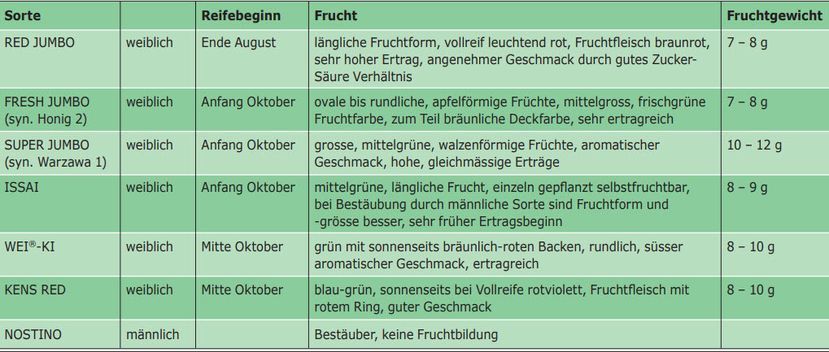
Rhubarb (Rheum rhabarbarum)
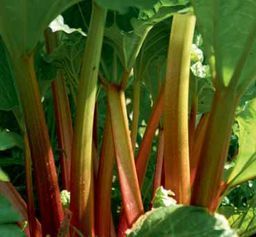
Professional growers should plant rhubarb in sunny locations. The ideal soil is medium heavy with a high humus and nutrient value, permeable and warms up easily. The pH value should lie between 5.6 and 7.2. The structure and aeration of the soil can be improved by adding compost, which will promote vigour in the plants. Because the volume of the leaves is so large and growth so fast, rhubarb needs a lot of water. Sprinkling during dry spells will promote growth and yield. One plant is usually planted per one square metre .

Figs (Ficus carica)
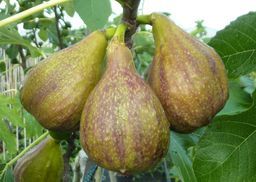
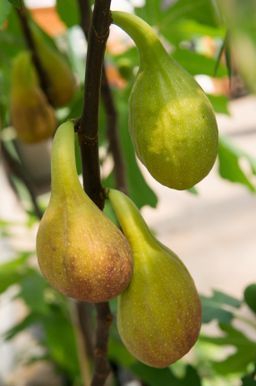
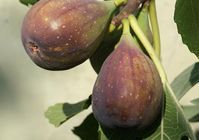
The fig is a deciduous shrub or small tree. It is undemanding, very adaptable and is increasingly successfully grown in our climate. The plants can produce two harvests a year if the weather is optimal. Decisive for success are the choice of variety and location. It is important to protect the plant from sun and wind during frost. The fig tree makes few demands on the soil, which should be well-drained and deep. Varieties with good cold tolerance are, for example, Nordland, Contessina and Brown Turkey.
NORDLAND
The Nordland-Berg Fig is characterised by excellent winter hardiness. It has a strong, compact growth. The large, violet coloured fruit ripen from August onwards. The fruit flesh is juicy and sweetly aromatic.
CONTESSINA
Like the Nordland variety, Contessina is also very resistant against the cold. The plant has a strong growth. This variety has a particularly high yield and produces very large, sweet and tasty violet fruit.
BROWN TURKEY
This variety of figs produces rather smaller fruit than Nordland and Contessina, but is just as hardy against winter. Brown Turkey is vigorous and produces a regular yield. The fruit ripen from mid August, are a dark violet colour and extremely tasty .

Siberian blueberry / Haskap (Lonicera caerulea var. kamtschatika)
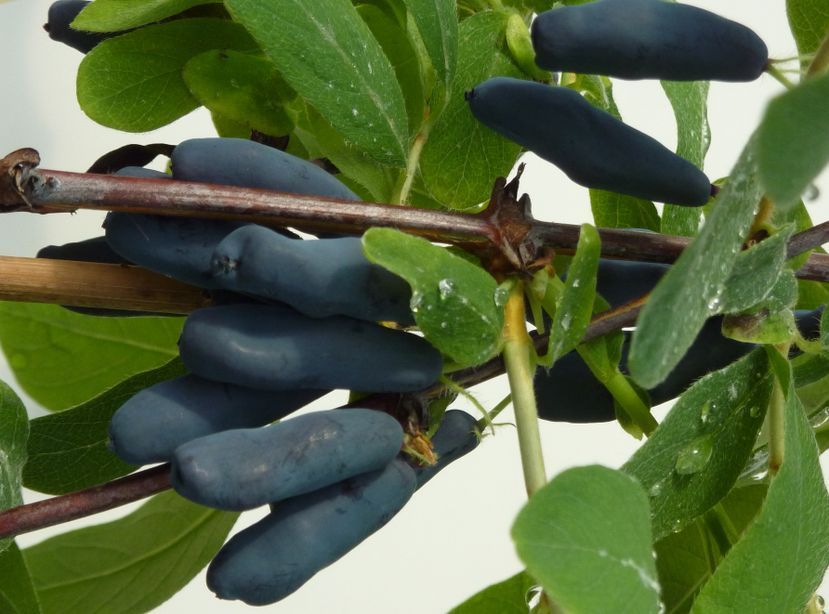
Maistar
Siberian blueberry is not a new breed, but a forgotten "superfruit", which makes an impressive new start thanks to new findings about your health benefits. The plant is extremely frost hardy and undemanding. The final height of the plants is about 1.20 m - 1.60 m, depending on the variety. To obtain a bountiful harvest, different varieties should be planted. The frost-insensitive flowers appear already in March/April, depending on the location. The oval to cylindrical, blue-ripe fruits can be harvested from the end of May, depending on the variety. They are suitable for fresh consumption and processing (juice, jam, food coloring, addition to yogurt, ice cream, etc.).
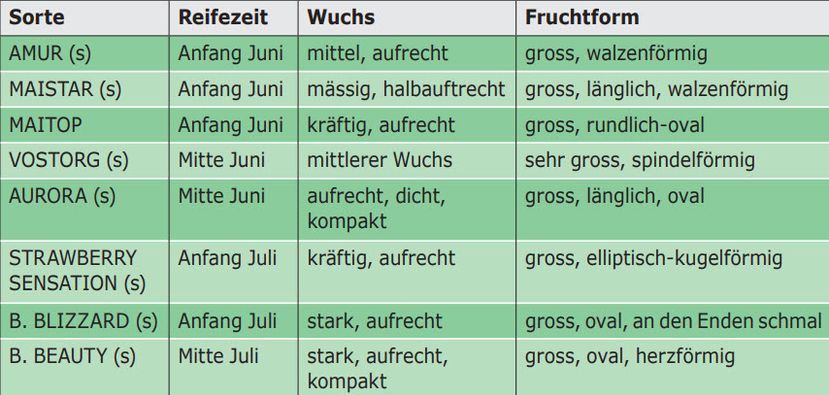
Alder-leaved serviceberry (Amelanchier alnifolia)
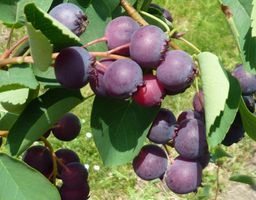
Fruit variety Northline

Rock pear blossom
The Amelanchier species comprises about 25 varieties, most of which originate from north America. Serviceberries are completely frost-hardy and undemanding. They stand out for their beautiful blossom, tasty fruit rich in vitamins and minerals, and wonderful autumn colour.
The “Northline” (Amelanchier alnifolia) variety is particularly attractive for commercial cultivation as its fruit are larger and ripen more evenly than the wild variety.
- Position: sunny to semi-shade
- Soil: any porous soil is suitable
- Growth: upright, usually with multiple stems, 2-4m high
- Blossom: April-May, free flowering, white Fruit: dark blue, sweet, firm, individual berries 12-13mm
- Uses: fresh, dried or processed (juice, liqueur, conserves,…)
Chokeberry (Aronia melanocarpa)
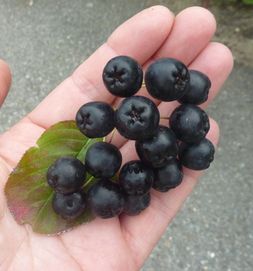
Chokeberries originate from north east America and belong to the rose family. The bushes of the cultured form reach a height of 1.5 to 2 m. Chokeberries are very undemanding, adaptable and extremely hardy against frost The fruit are not suitable for eating fresh but are useful for making juice, wine, liqueur, jellies and preserves. Chokeberries contain high levels of anthocyan pigments, flavonoids, vitamins and minerals. The main varieties grown for fruit production are "Viking", "Nero" and "Hugin".
Goji berry (Lycium barbarum)
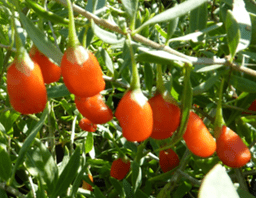
Goji berry (Lycium barbarum)
Lycium barbarum has made its way as a new fruit type under the name "Goji berry". The alternative names of Boxthorn or Wolfberry are perhaps less spectacular. The wood is undemanding and frost-hardy. Any ground that is not water-logged would be tolerated, but the ideal pH value lies from 5.7–6.5. The plants fruit on that year's new growth. They flower from about mid July and fruit from August to the first frosts. The average height of the bushes is from approx. 1.5 m to 2 m (in the wild, they may grow even higher). This species is very resistant to disease and pathogens, though some varieties may occasionally show powdery mildew and gall mites.
Crimson Star
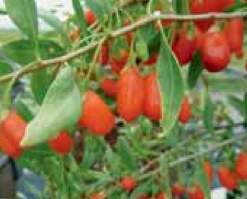
- Early fruiting variety
- High-yield
- Fruitcolour strong orange
- Pleasant, sweet flavour
- Enjoy fresh or dried
- Berries contain high levels of vital substances
Elderberry (Sambucus nigra)
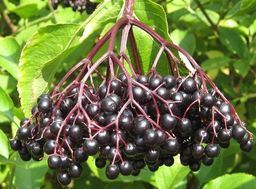
The black elderberry can certainly be called an all-rounder. The wide range of healing powers in its flowers, leaves and fruit have been treasured from time immemorial (though they must not be eaten raw). By now, it is used in medication, foods and for its pigmentIn. Europe, the major areas where it is cultivated centre upon Austria and Germany. The Haschberg variety has become the standard in these countries, on the basis of long experience.
Sea buckthorn (Hippophae rhamnoides)
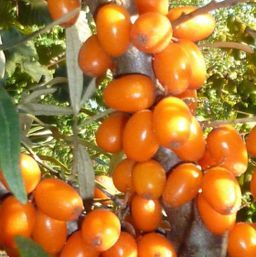
Sea buckthorn is a deciduous shrub that can reach a height of 6 m, depending on the variety. Its root system is deep and extensive. It prefers calcareous sandy and gravelly soils in a sunny position.
Because buckthorn is dioecious, male and female plants must be planted for fruit production. The flowers appear from March to May. The female plants bear countless orange-red fruits starting in August.
The exceptionally high vitamin C content makes sea buckthorn particularly interesting

Pawpaw (Asimina triloba)
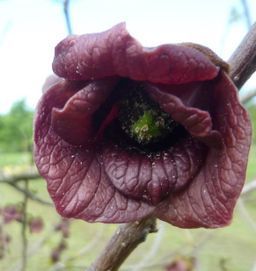
In Central Europe, the Pawpaw is still hardly known. This robust and very frost-hardy plant prefers a sunny, not too hot location with well-drained, humus-rich soil.
To obtain a reliable yield, two varieties should be planted. The elongated-oval to club-shaped fruit can weigh up to 400 g. Ripening begins around the end of September. The consistency of the creamy white to yellowish flesh resembles a banana to avocado. The taste is sweet and tropical. The fruits are eaten without the skin.
In addition to fresh consumption, further processing into jams, ice cream, milkshake or mixed juices is possible.
Varieties: PRIMA 1216, SUNFLOWER
Grapevine (Vitis vinifera / Vitis vinifera x V. labrusca)
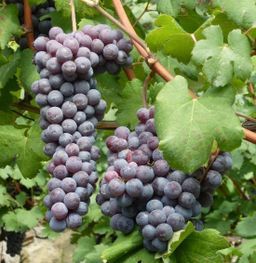
Grapevines are among the oldest cultivated plants in the world. Most of the up to 10,000 grape varieties belong to the wine grape, which is processed into wine. Colloquially, wine grape usually stands for table grapes, which are sold as a popular fruit. Table grapes have larger berries and thinner skins than wine grapes.
Various crossings have been made between the European grapevine (Vitis vinifera) and the American grapevine
(Vitis labrusca) to combine the best characteristics of both
(e.g., flavor, plant health).
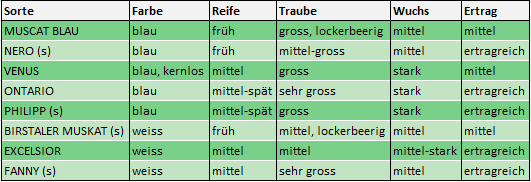
Practical information
- Schulstrasse 62
9323 Steinach(SWITZERLAND)
- Mon - Fri
- - -
- Sat - Sun
- Closed
Please note:
We propagate plants for commercial cultivation. Individual plants to private individuals cannot be offered.



